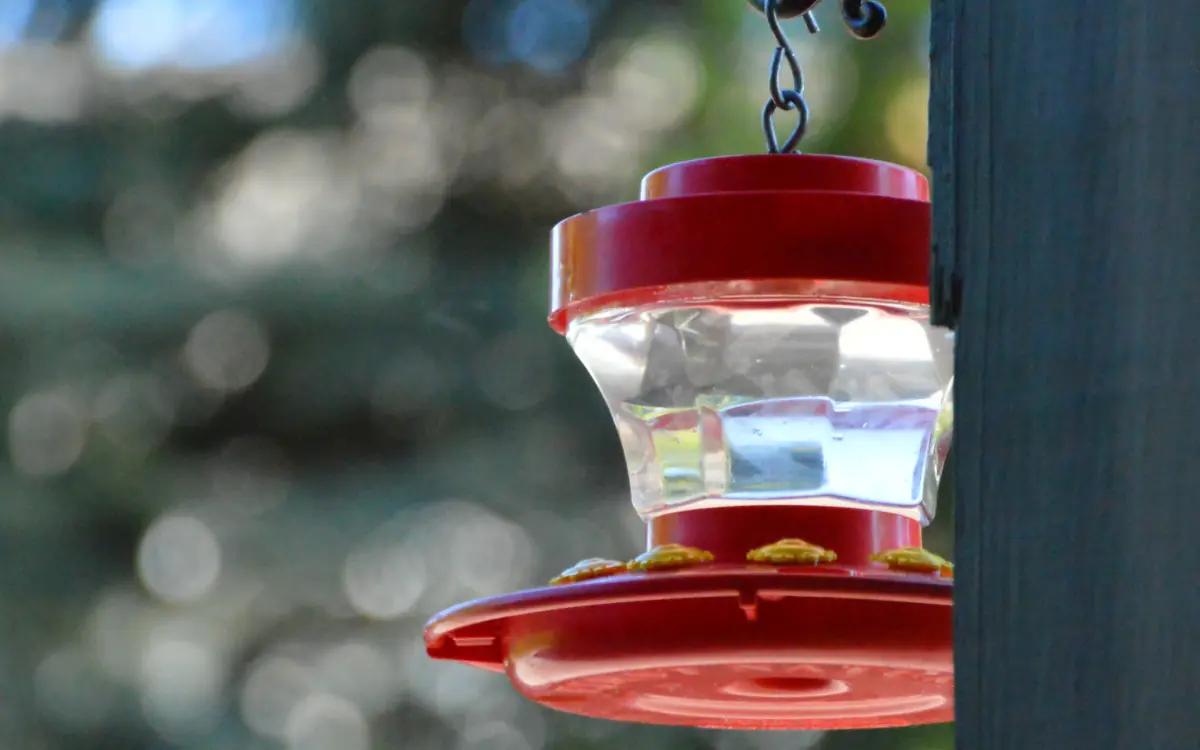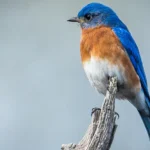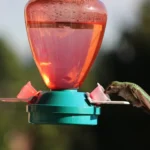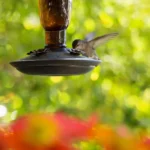Bees often swarm hummingbird feeders, attracted by the same sweet nectar that hummingbirds love. While bees play an important role in pollination, their presence at feeders can be a nuisance, overwhelming the birds and causing maintenance issues.
Fortunately, there are several simple and effective methods to reduce bee activity around your hummingbird feeder, keeping both the bees and birds safe while maintaining a peaceful feeding environment.
Tip 1: Use Feeders with Bee Guards
Bee guards are small mesh-like barriers placed over the feeding ports of hummingbird feeders. These guards are designed to allow the long, slender beaks of hummingbirds to reach the nectar while preventing bees, with their shorter tongues, from accessing it.
By blocking bees from the feeding ports, bee guards help reduce bee activity without interfering with the hummingbirds’ ability to feed.
When choosing a feeder, opt for one that comes with built-in bee guards to keep bees away from the nectar.
If your existing feeder doesn’t have them, you can purchase bee guards separately and attach them to the feeder’s ports. This simple solution ensures that the hummingbirds can feed peacefully while keeping bees at bay.
Tip 2: Opt for Red Feeders Over Yellow
Bees are naturally more attracted to the color yellow, associating it with pollen and nectar sources. In contrast, hummingbirds are drawn to red, which makes color an important factor when selecting your feeder.
To deter bees, choose feeders that are primarily red in color. This will help minimize bee interest while still attracting hummingbirds.
If your feeder has yellow parts, such as flowers or accents, consider replacing them with red parts or painting them a different color to make the feeder less appealing to bees.
By reducing the presence of yellow, you can significantly lower the chances of bees swarming the feeder, allowing the hummingbirds to enjoy the nectar undisturbed.
Tip 3: Move the Feeder to a Shadier Spot
Bees are naturally drawn to sunny, warm areas, where nectar is easier for them to locate. On the other hand, hummingbirds are just as comfortable feeding in shaded spots as they are in the sun.
By relocating your feeder to a shaded area, you can effectively reduce bee activity without discouraging hummingbirds.
Place your feeder under a tree, on a covered porch, or near other shaded locations in your yard. The cooler, darker environment will make it harder for bees to find the nectar, while hummingbirds will continue to visit.
This simple adjustment can significantly minimize bee presence and help create a more peaceful feeding spot for the birds.
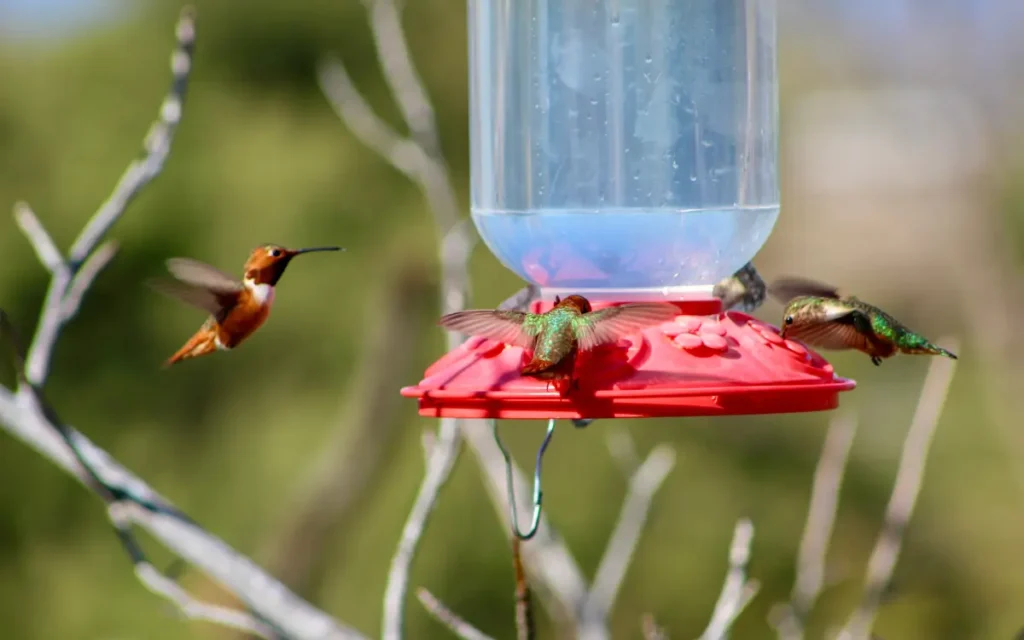
Tip 4: Offer Bees an Alternative Source
One effective way to keep bees away from your hummingbird feeder is to provide them with an alternative food source.
You can offer bees a shallow dish filled with sugar water (using a 1:1 sugar-to-water ratio) placed well away from the hummingbird feeder.
This diversion gives the bees their own supply of nectar-like food, keeping them busy and reducing their interest in the hummingbird feeder.
Position the dish in a sunny area, where bees are naturally more active, and check it regularly to ensure it remains filled.
By giving bees an alternative source of nectar, you help them feed while allowing the hummingbirds to enjoy their feeder in peace.
This method benefits both bees and birds without the need for harmful chemicals or aggressive deterrents.
Tip 5: Adjust the Nectar Recipe
Bees are more attracted to sweeter nectar, so one way to reduce their interest in your hummingbird feeder is by sticking to the proper nectar recipe: 1 part sugar to 4 parts water.
This ratio is perfect for hummingbirds but less appealing to bees, which are drawn to stronger concentrations of sugar.
Avoid increasing the sugar content, as a higher concentration makes the nectar more attractive to bees and other insects. By keeping the sugar level lower, you’ll still provide the necessary energy for hummingbirds while discouraging bees from swarming the feeder.
Sticking to this ratio ensures the feeder remains appealing to hummingbirds without unnecessarily attracting bees.
Tip 6: Clean the Feeder Regularly
Regular cleaning of your hummingbird feeder is crucial in preventing bees from being attracted to it. Spilled nectar, even in small amounts, creates a sweet scent that quickly draws bees.
To avoid this, make sure to clean the feeder thoroughly each time you refill it.
After filling the feeder, wipe down the exterior to remove any sticky residue that may have spilled. Pay special attention to the feeding ports and surrounding areas, as bees will quickly be drawn to any nectar left outside the feeder.
Regular cleaning not only keeps the bees away but also ensures a healthy feeding environment for hummingbirds.
Keeping the feeder free from spills and sticky spots is a simple yet effective way to reduce bee activity.
Tip 7: Reduce the Number of Feeding Ports
Limiting the number of open feeding ports on your hummingbird feeder can help reduce bee access while still allowing hummingbirds to feed comfortably. Bees tend to swarm open feeding ports, so reducing their number can significantly cut down on bee activity.
If your feeder has multiple ports but isn’t used by many hummingbirds at once, consider closing off some of the unused ports. You can use stoppers or rubber caps to block them.
Alternatively, switching to a feeder with fewer ports is another effective option.
This approach minimizes the areas where bees can access nectar while ensuring that hummingbirds still have enough space to feed.
By reducing the number of feeding ports, you can create a more manageable and bee-free environment around your feeder.
Conclusion
By using bee guards, adjusting the nectar recipe, placing the feeder in the shade, and cleaning regularly, you can effectively keep bees away from your hummingbird feeder. Additionally, reducing the number of feeding ports and offering an alternative food source for bees can further minimize their presence. Try a combination of these tips to maintain a bee-free feeder, creating a safe and welcoming space for hummingbirds to enjoy.

